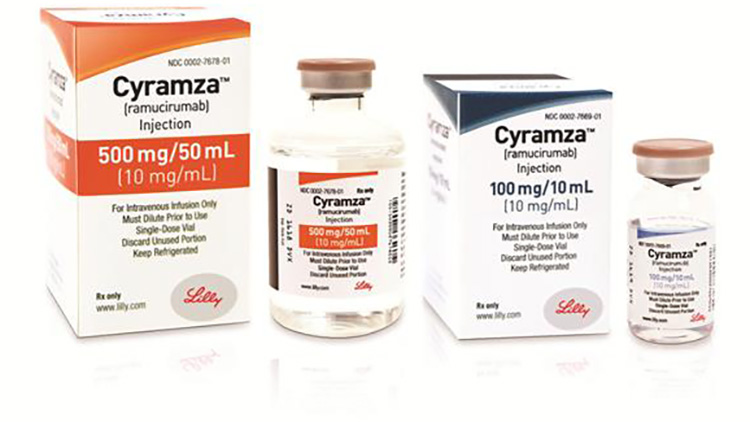Cyramza (ramucirumab) vs Tabrecta (capmatinib)
Cyramza (ramucirumab) vs Tabrecta (capmatinib)
Cyramza (ramucirumab) is a monoclonal antibody designed to target and inhibit the vascular endothelial growth factor receptor 2 (VEGFR2), which can slow the growth of new blood vessels that tumors need to grow; it is commonly used to treat various types of cancers, including stomach cancer, colorectal cancer, and non-small cell lung cancer (NSCLC) with certain characteristics. Tabrecta (capmatinib), on the other hand, is a selective inhibitor of the c-Met receptor tyrosine kinase, which is implicated in the growth and development of some cancers, and is specifically approved for the treatment of adults with metastatic NSCLC that has a mutation leading to MET exon 14 skipping. When deciding between these two medications, it is crucial to consider the specific type of cancer and its molecular profile, as Tabrecta is tailored for a specific genetic alteration in NSCLC, while Cyramza is used for a broader range of cancers but requires the presence of a suitable target for VEGFR2 inhibition.
Difference between Cyramza and Tabrecta
| Metric | Cyramza (ramucirumab) | Tabrecta (capmatinib) |
|---|---|---|
| Generic name | ramucirumab | capmatinib |
| Indications | Gastric cancer, non-small cell lung cancer, colorectal cancer, hepatocellular carcinoma | Non-small cell lung cancer (NSCLC) with MET exon 14 skipping mutations |
| Mechanism of action | Angiogenesis inhibitor by VEGFR-2 antagonism | Small molecule kinase inhibitor targeting MET |
| Brand names | Cyramza | Tabrecta |
| Administrative route | Intravenous | Oral |
| Side effects | Hypertension, diarrhea, headache, hyponatremia | Nausea, vomiting, fatigue, edema, dyspnea |
| Contraindications | Hypersensitivity to ramucirumab or any excipients | Hypersensitivity to capmatinib or any excipients |
| Drug class | Monoclonal antibody | Tyrosine kinase inhibitor |
| Manufacturer | Eli Lilly and Company | Novartis Pharmaceuticals |
Efficacy
Efficacy of Cyramza (Ramucirumab) in Lung Cancer
Cyramza (ramucirumab) is a monoclonal antibody that targets the vascular endothelial growth factor receptor 2 (VEGFR2), which is implicated in the growth of blood vessels that supply tumors with nutrients and oxygen. In the context of non-small cell lung cancer (NSCLC), Cyramza has been evaluated for its efficacy in patients with advanced-stage disease. Clinical trials have demonstrated that when used in combination with docetaxel, Cyramza can provide a statistically significant improvement in overall survival compared to docetaxel alone in patients with metastatic NSCLC who have progressed on or after platinum-based chemotherapy. This improvement in survival indicates Cyramza's potential as a second-line treatment option for NSCLC.
Efficacy of Tabrecta (Capmatinib) in Lung Cancer
Tabrecta (capmatinib) is an oral kinase inhibitor specifically designed to inhibit the activity of the MET proto-oncogene, which can lead to MET exon 14 skipping mutations. These mutations are a recognized driver of certain types of NSCLC. The efficacy of Tabrecta has been evaluated in a multicenter, non-randomized, open-label, multi-cohort study. The results have shown that Tabrecta led to a high rate of objective response rate (ORR) in patients with metastatic NSCLC harboring MET exon 14 skipping mutations. The ORR and duration of response (DoR) observed in these studies suggest that Tabrecta is a promising targeted therapy for this specific patient population.
Comparative Considerations
While both Cyramza and Tabrecta are used in the treatment of NSCLC, their mechanisms of action and the specific patient populations they target differ significantly. Cyramza is generally considered for a broader NSCLC patient population as a second-line treatment, whereas Tabrecta is tailored for a subset of patients with MET exon 14 skipping mutations. The choice of therapy is highly dependent on the molecular profile of the tumor and previous treatments the patient has undergone. Therefore, molecular testing for MET exon 14 skipping mutations is crucial in determining the suitability of Tabrecta for individual patients.
Conclusion
In conclusion, both Cyramza and Tabrecta have shown efficacy in treating certain populations of patients with NSCLC. Cyramza, in combination with docetaxel, has been shown to improve overall survival in a second-line setting, while Tabrecta has demonstrated a high ORR in patients with MET exon 14 skipping mutations. The selection of either drug should be based on a comprehensive evaluation of the patient's specific type of lung cancer and genetic mutations present, as well as considering the patient's overall health and prior treatments.
Regulatory Agency Approvals
Cyramza
-
European Medical Agency (EMA), European Union

-
Food and Drug Administration (FDA), USA

-
Health Canada

-
Therapeutic Goods Administration (TGA), Australia

-
Medsafe (NZ)

Tabrecta
-
European Medical Agency (EMA), European Union

-
Food and Drug Administration (FDA), USA

-
Pharmaceuticals and Medical Devices Agency (PMDA), Japan

Access Cyramza or Tabrecta today
If Cyramza or Tabrecta are not approved or available in your country (e.g. due to supply issues), you can access them via Everyone.org.
How it works

Make an enquiry
Choose the medicine you want to buy, answer a couple of questions, and upload your prescription to speed things up. We’ll get back to you within 24 hours.


Make an enquiry
Choose the medicine you want to buy, answer a couple of questions, and upload your prescription to speed things up. We’ll get back to you within 24 hours.


Breeze through the paperwork
We'll guide you through the required documents for importing unapproved medicine, ensuring you have all the necessary information.


Get a personalized quote
We’ll prepare a quote for you, including medicine costs and any shipping, administrative, or import fees that may apply.


Receive your medicine
Accept the quote and we’ll handle the rest - sourcing and safely delivering your medicine.

Some text on this page has been automatically generated. Speak to your physician before you start a new treatment or medication.
Let's talk
If you have any questions, call us or send us a message through WhatsApp or email:
Contact us




